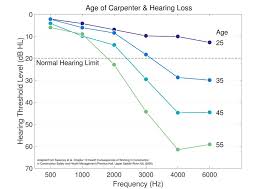Age related decrease in hearing occurs gradually in every person during life.
The ability to hear depends on the inner ear (cochlea), precisely encoding sound into neural signals, which are then processed and de coded into meaning at the cortical level of the brain.
Age related hearing loss, impairs hearing and diminished auditory afference can directly affect brain function and structure.
Age related hearing loss (ARHL) is characterized by progressive loss of the sensory hair cells of the inner ear.
Age related hearing loss results from the combined effects of multiple etiologic factors that occur over one’s lifetime.
These cells are responsible for encoding sound into neural signals.
Sensory hair cells in the inner ear, cannot regenerate and are progressively lost over the course of life.
Risk factors for age related hearing loss include: older age, lighter skin color, as an indicator of cochlear, pigmentation, male sex, and noise exposure.
Other risk factors include cardiovascular disease risk factors, such as diabetes, smoking, hypertension, all of which can contribute to microvascular injury to cochlear blood vessels.
In early adulthood, hearing begins to diminish, particularly with regard to sounds, in higher frequencies.
Clinically significant hearing loss increase during the lifespan, with a nearly doubling with every decade of life such that more than 2/3 of all adults 60 years of age or older, have some form of clinically significant hearing loss.
In 2019 it was estimated that almost 73,000,000 people, or one in five individuals had hearing loss.
Hearing loss is associated with impaired communication, cognitive decline, dementia, higher medical costs, and other adverse health outcomes.
Hearing loss in middle, and late life is the single largest, potentially modifiable risk factor for dementia, accounting for 8% of all dementia cases.
Theoretically, the risks of cognitive decline and dementia include adverse effects of hearing loss and impoverished, auditory encoding of sound on cognitive functions, brain, atrophy, and social isolation.
Management seeks to enhance a person’s access to speech and other sounds in the auditory environment, to promote effective communication, engagement with daily activities, and safety.
No restorative therapy exists for age related hearing loss and management is focused on hearing protection, adopting strategies to optimize the quality of the incoming auditory signal, and the use of hearing technologies, such as hearing aids and cochlea implants.
In the US, the prevalence of hearing aid use is below 20% that of cochlea implantation is less than 5%.
Hearing protection strategies, focus on reducing noise, exposure by moving away from or reducing the volume of the sound source, and by using hearing protection devices.
Encouraging communication strategies, such as face-to-face, and arms length conversations to allow a clear auditory signal and for listener to use visual access to facial expressions and lip movements that can aid in understandings the speech signal.
Hearing aids are the primary treatment for age related hearing loss as they amplify sound and can increase the signal-to-noise ratio of the desired target sound by means of directional microphones, and digital signaling processing which can improve communications in noisy settings.
Over-the-counter hearing aids are intended for adults with mild to moderate levels of hearing loss of generally less than 60 decibels, which encompass 90-95% of all persons with hearing loss.
Prescription hearing aids have higher levels of sound output and can be used by adults with more severe levels of hearing loss.
Hearing aid use in adults, improves outcomes of both hearing specific and general health related quality of life.
A study comparing health education and hearing aid use found that hearing aids reduced three-year cognitive decline in adults 70 to 84 years of age with hearing loss (ACHIEVE).
Individuals with hearing loss of greater severity of 60 dB and continue to have difficulty with understanding speech, despite the use of hearing aids, may be candidates for a cochlear implant.
Cochlear implant may improve speech and understanding and communication and be a life-changing process for many adults.
Categories

